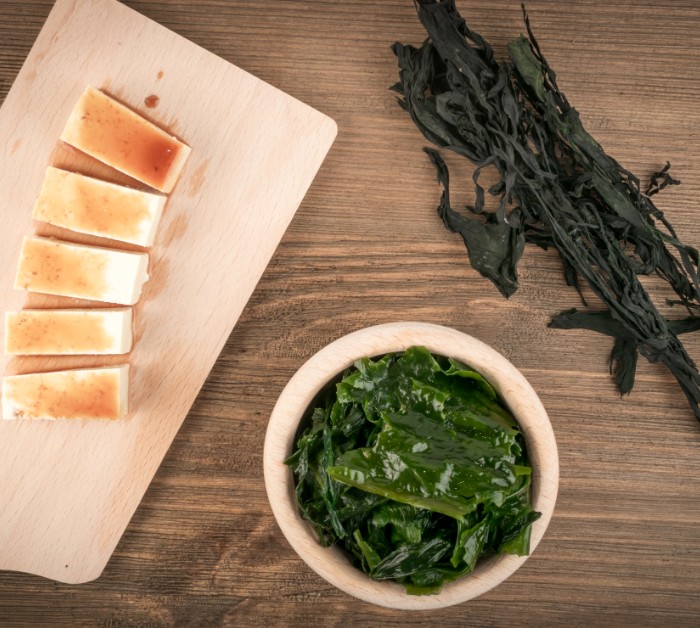Most common types of edible seaweed
Seaweed – a vegetable of the sea. Maybe you’ve heard about seaweed but have you ever tried one? Maybe you don’t know much about these sea vegetables?
They are part of many meals in Asia for thousands of years and now they are taking their place in our Western diet too.
Here we’ve made a list of different types of edible seaweed with their characteristics and how to use them. Each of these seaweeds is rich in specific nutrients like proteins, minerals, vitamins, fiber…
This post may contain affiliate links, which means we may receive a small commission, at no cost to you, if you make a purchase through a link. For more information, please see our disclosure.
What is edible seaweed?
Edible seaweed or sea vegetables are aquatic plants known as algae that grow in the ocean. There are three main categories of these edible seaweeds as red, green, and brown algae in which they are further segregated.
Even these sea vegetables are known as part of Asian cuisines, today they are very popular ingredients in our Western diet too. Different types of seaweed are used for preparing salads, soups, main course meals, etc.
Their use is more popular because they are tasty but also they bring with them a long list of health benefits.
How is seaweed produced?
Seaweed can be harvested from clean, fresh, unpolluted ocean waters. While some seaweeds are harvested directly from their natural environments, seaweed farming produces much more of these sea vegetables today.
Farmers use saltwater tanks to grow seaweed, most others have the equivalent of garden plots out of the sea. The simplest and most common cultivation method is to attach pieces of seaweed to rope lines or nets that are suspended in the sea often near the coast. They hang on wooden stakes or on a floating wooden framework dug down into the seabed.
The global seaweed market reached a production value of US$ 8.8 Billion in 2019. According to the World Bank document producing large volumes of seaweed not just for human food, but also as animal feed and biofuel could represent a transformational change in the global food security equation and in the way we view and use the oceans.
According to this document in 2012 global production of seaweeds was approximately 3 million tons dry weight, and growing by 9% per annum.
Increasing the growth of seaweed farming up to 14% per year would generate 500 million tons of dry weight by 2050, adding about 10% to the world’s present supply of food, generating revenues, and improving environmental quality.
Currently, 80% of total seaweed production is for human consumption eaten dried or fresh for its nutritional value or for flavoring.
The remaining 20% is used as a source of the phycocolloids extracted for use in the food, industrial, cosmetic, and medical industry as well as for animal feed additive, fertilizer, water purifier, and probiotics in aquaculture.
Different types of seaweed
There are many types of seaweed to eat and all of them have different nutritional and health benefits. It is up to you to choose one and use it for your meals.
Kelp
The most available type of edible seaweed is kelp, which belongs to the category of brown algae. It’s a very fast-growing seaweed, tacking on about 1.5 feet per day according to National Park Service.
You can find kelp in its dried form, soaking it for several minutes makes it edible and can be used in soups and other recipes. Also, kelp comes in granulated form and this can be used in place of salt or as a mineral supplement to your food.
There are several types of Kelp weeds that you can add to your diet, but the most widely used ones are Kombu, Wakame, and Arame.
Kombu
Kombu is a subvariety of kelp and it belongs to the group of brown seaweeds known as Laminariacea. It is one of the most popular edible seaweeds in East Asia.

Cooked in water with bonito (skipjack tuna) flakes, kombu is the main ingredient of dashi soup. Because this seaweed poses nutritional value and flavor unlike any other seaweed it is called “The King Of Seaweeds”.
Good To Know: From all seaweeds, Kombu has the highest average iodine content 2523.5 mg/kg. This provides almost 2000% of the recommended daily intake. The recommended daily intake (RDI) of iodine is 150 mcg per day for adults.
Loaded with vitamins, minerals, antioxidants, and healthy fats kombu seaweed can be consumed fresh (sashimi), dried, pickled in vinegar, or its powdered form can be used to brew the Japanese tea kombucha, which is different from the fermented drink popular in the U.S.
Read more: Kombu Seaweed: Powerful Sea Food-Benefits and Side Effects
Wakame
In this list of edible seaweeds, we must mention wakame too. Wakame is classified as brown kelp even though its thick slippery fonds are dark green in color.
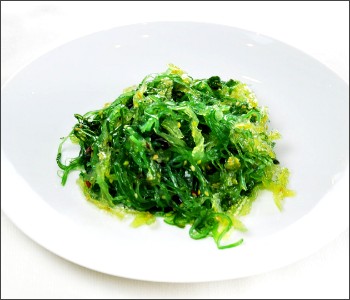
In English, it can be also called “sea mustard”, not because of its mild flavor, which, unlike the peppery vegetable, it’s because it resembles mustard greens when cooked.
If you order regularly Chinese food you’ve probably eaten a wakame without knowing. It is a common ingredient in cold salads (cucumber seaweed salad), or as a topping on tofu, rice, sushi, and miso soup.
Next time when you’re in a Chinese restaurant we recommend trying fresh wakame tossed with a bit of sesame oil over a bed of lettuce.
Like most seaweeds, wakame has a salty umami flavor, with a degree of sweetness as well. When it comes to texture rehydrated wakame has a slightly rubbery, slippery texture, and dried form straight from the bag resembles slightly chewy potato chips.
Good To Know: When you use wakame for soups don’t add too much as it expands greatly in size after being cooked.
A great source of omega-3 fatty acids, wakame seaweed comes usually packed dried or salted in vacuum packs, and it expands greatly in size after being cooked.
Read more: Benefits Of Wakame Seaweed and How To Use It
Arame
This type of seaweed also belongs to the Kelp family. Arame is dark brown in color and it’s known as iron-rich seaweed because it is an excellent source of iron and iodine. A tablespoon of dried arame will give you 0.7 mg of iodine.

It has a sweet, mild flavor which makes it a great sea vegetable for beginners. Soak dried arame for five minutes before using, then toss the arame into salads with butternut squash, pumpkin seeds, rice vinegar, and sesame oil.
Dulse
Dulse is a red alga also known as sea lettuce flakes, red dulse, etc. Extremely rich in iodine, vitamin A, B-12, and vitamin C, fiber, and valuable minerals.
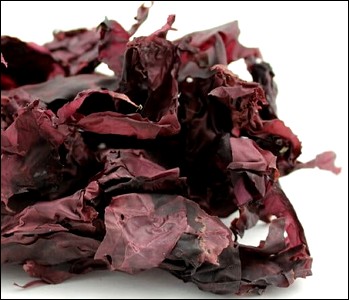
This sea vegetable has a soft, leathery texture and the most interesting thing is that has a taste reminiscent of bacon and can also be cooked up in oil until crispy. This makes it dulse a popular bar snack in Canada.
Used in soups, baked into chips, or even as a meat seasoning dulse comes in dry flakes, shredded, or ground into powder. Also, fresh dulse can be sauteed with butter and garlic, or rubbed with olive oil and salt and roasted in the oven to make chips.
Read more: Benefits Of Eating Dulse Seaweed-Secret Sea Vegetable
Hijiki
This sea vegetable is naturally brown while growing but it turns black after being boiled and dried upon collection.
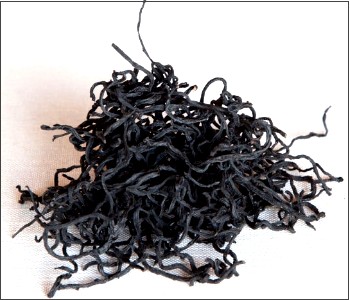
Hijiki is sold in dried form and needs to be re-hydrated every time before consuming it. After soaking in water the weeds looks like black noodles and these can be used as decorative ingredients in various coastal food preparations. It’s often cooked in stir-fries or served with fish.
Rich in dietary fiber and minerals like iron, magnesium, and calcium it’s been touted as a health and beauty aid in Japanese folklore.
We must mention that some studies suggest that hijiki contains high levels of inorganic arsenic and it’s advised to consume hijiki only occasionally.
Nori
Maye, you didn’t hear by now about nori seaweed, but you’ve probably already tasted this seaweed if you have eaten sushi.
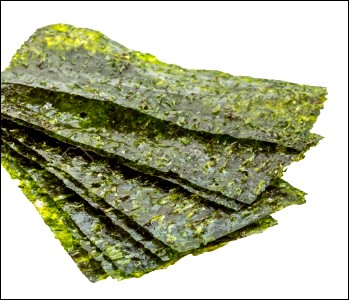
This type of edible seaweed is a deep purplish-red in a color that turns dark green when dried. Compared to other sea vegetables it’s fairly low in minerals and other nutrients and this is not bad, because you can eat even more of it.
Nori seaweed also called in U.S. laver is made by shredding edible seaweed and pressing it into thin, dried sheets that appear either dark green or black.
Japanese restaurants use nori to wrap sushi rolls and rice balls (onigiri), you can use it at home for soups, fry it with some vegetables, tossed in salads.
Aonori is the powdered form and it’s used as a flavoring ingredient in traditional Japanese dishes like pancakes (okonomiyaki) and buckwheat noodles (yakisoba).
Read more: Nori Seaweed | Benefits, Side Effects and More
Irish Moss
From all different types of seaweed, Irish Moss is widely known and most used.
Irish Moss or just called Sea Moss is a type of purple and red alga that grows on the Atlantic coastlines of the U.S. and Europe. You can also find it by the name carrageen moss-carrageenan the most common thickening agent that makes up about 55% of Irish moss bulk.

When heated in liquid it softens like a jelly-like substance, so people in the Caribbean boil Irish Moss until it’s jelly and flavors it with vanilla and cinnamon, and top it off with milk and rum, a great drink. It is believed that this drink is good to fight impotence and has aphrodisiac properties.
In countries like Ireland and Scotland, it is boiled in milk and strained before sugar and flavorings such as vanilla, cinnamon, brandy, and whiskey are added or made into bread.
Today you can find Irish Moss fresh, dried form, or powdered. There are also Sea moss gummies, Irish Moss gel, and lotion.
To find out more about Irish Moss, what are the benefits and potential side effects, and how to use it properly read this article below.
Read more: Irish Moss: Benefits and Side Effects That You Should Know
Sea Lettuce, Ulva
Ulva or Sea Lettuce is another type of edible seaweed that we must mention in this list. It is a bright green alga that is primarily found along coastlines, mainly in areas of exposed rocks and in stagnant tide pools.
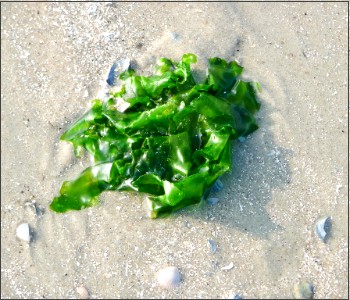
Nutritionally Ulva has 87 mg of iron per 100-gram portion and 700 mg calcium per 100-gram serving. High in protein, iodine, aluminum, manganese, vitamins A, B1, C.
Commonly known as Sea Lettuce or Green Nori, it can also be used as a substitute for Nori in making sushi. Ulva (Sea Lettuce) should be washed well then use or as an option soak it in water for two hours before using it to moderate the flavor.
Like lettuce grown on land, this seaweed can also be used for salads and soups. Sea Lettuce is also used to make ice cream, other food products, and medicine.
How to safely use different types of edible seaweed in your diet
The texture of seaweed is unique and some (many) people don’t like eating these sea vegetables by themselves. But the best way to extract the bulk of nutrients and minerals from seaweed is to add to soups and broths.
If we go back, historically these sea vegetables were used as flavorants, stock bases, garnishes, and side dishes. Because they are rich in iodine you must be careful with the amount that you consume. By consuming a lot of seaweed your iodine levels may go up which is not good for your thyroid health.
So the best way to consume these sea vegetables is to think of them as a supplement or as we mention up here as they have been used for centuries as flavorings, garnishes, and side dishes.
There is little concern about heavy metal or pollutant toxicity due to the consumption of sea vegetables. If sea vegetables soak up all the beneficial compounds floating around our oceans, it seems plausible that they’d also absorb the bad stuff – mercury, arsenic, lead. This is not the case and there are many studies that show that this is not true.
Except for one warning, like we mentioned before you must be careful with only one type of edible seaweed-hijiki. It is shown that hijiki contains high levels of inorganic arsenic and it is best to avoid this seaweed. So, the best choice is to avoid hijiki and don’t consume it.
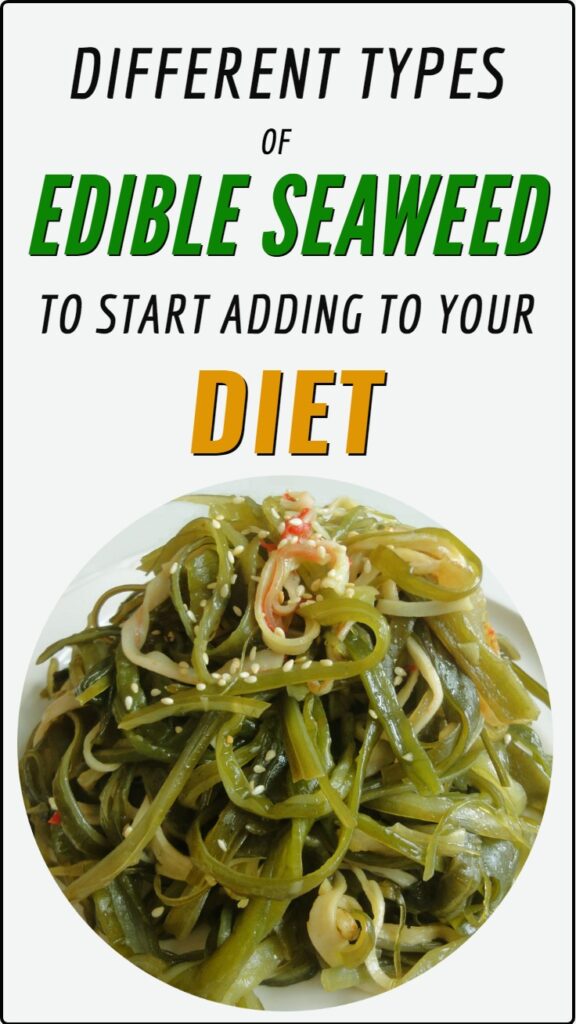
Final thoughts about edible seaweed
These are the most used edible seaweed and there are also other types that we didn’t mention here like: Marsh Samphire, Bladderwrack, Agar-Agar, etc…
For all edible seaweeds is common that all are used to add an extra flavor to soups, salads, a regular ingredient in smoothies, dried seaweed snacks are a popular alternative to chips. There are little recipes where seaweed is the main ingredient.
Rich with vitamins, minerals, fatty acids no matter what seaweed you will choose you won’t make a mistake. Just remember that all of them are especially iodine-rich. If you have any problems with your thyroid or you take medications related to thyroid function we recommend avoiding adding seaweed to your diet.
If you haven’t tried or made a meal with seaweed it is about time to try one, it is up to you to choose wakame, nori, kombu, dulse they all are tasty and yes, have a long list of benefits for your health.

